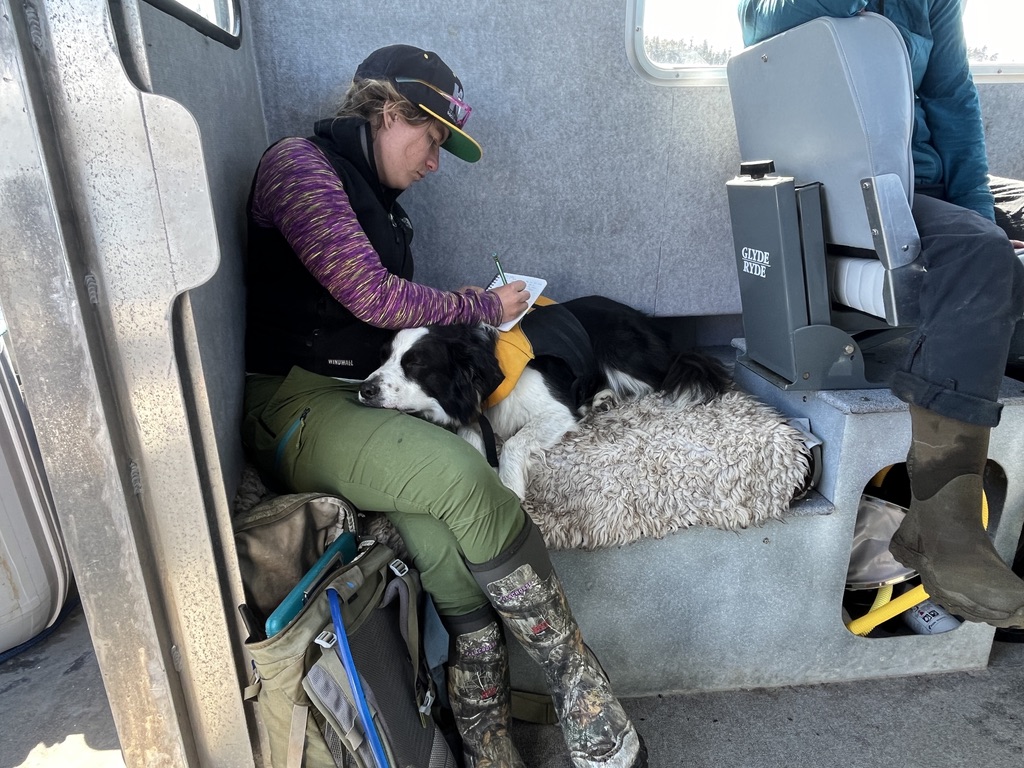Barley is snoring softly with his tongue poking out the front of his mouth. His warmth fills the nook behind my knees the way a river pours into a canyon. My calves and hamstrings give him shape, keep him from slipping right off the tiny cot. Perhaps he is liquid, perhaps he shapes my life the way a river forms a canyon. Perhaps I channel and contain his enthusiasm and joy and raw talent the way a canyon shapes a river. If he is a river, usually he is a Class V river at high water, powerful and roaring and carrying a thousand logs, shaping the very rock around him. (At ten years old, after two 10km search days in a row, he busted through a canvas tent while I was at a cafe to write this very paragraph).
If I had not happened to be in his way, happened to be the just-right rock that he carved into when I was just 23, I would not be here. In a tent, in Alaska, in the rain, with dozens of wolf scats on my to-do list. I have built my life around channeling his power; sculpted a nonprofit into being to direct his drive and sparkle to conservation goals. As I feel his warmth along my legs, watch his gentle breathing, I know I am trying to memorize a mirage. But I have to try. He is slipping through my fingers as if I tried to lasso the current of my beloved Bitterroot River. It is impossible to hold onto him, impossible to surf the wake of his talent forever. I know I will lose him someday. Dread makes me curl a bit tighter around him.
It is barely 5am but it is bright outside, even with the rain. I will not be able to fall back asleep. Today is a rest day, which really means it is chock-full of to-do items. Check email. Digitize field notes. Organize data sheets. Charge electronics. Dry gear. Do laundry. Put scat into PCR tubes. Run errands. Massage Barley. Brush Barley. Stretch Barley. Feed Barley. Maybe, just maybe, massage and stretch my own aching muscles.

I roll up to sit cross legged, breaking the walls of Barley’s canyon. He spills outward, stretches and yawns and shakes and puddles again atop my crossed ankles. I curl forward and reach outward to encircle him, finding tightness in my shoulders and back and hips. I bow my head and close my eyes, pressing my forehead into his flank. Morning prayer complete, I slip on my rain jacket. Scat and emails and data sheets and GPS points and powdered eggs and canned beans and chai masala beckon.
***
Our next search is in one of the thousands of inlets on Dall Island where we can pick our way up a draw lined with minimal Devil’s club to reach a logging road. Stretched and massaged and brushed and rested, Barley gleams. He looks four, maybe five years old; not a trace of the tender, sore, tentative old man dog that haunted my mornings just a few days ago. I know that ghost will be back someday, but not today. Today he is strong and vibrant, with a nose full of spruce-after-rain and salt-on-the-breeze. It is sunny and almost warm. Removing layers of waterproof Nylon and wicking Spandex, I shoulder my pack over skin and a sports bra. The sun feels like slipping into a hot spring after a chilly hike, a physical pressure to its comfort.
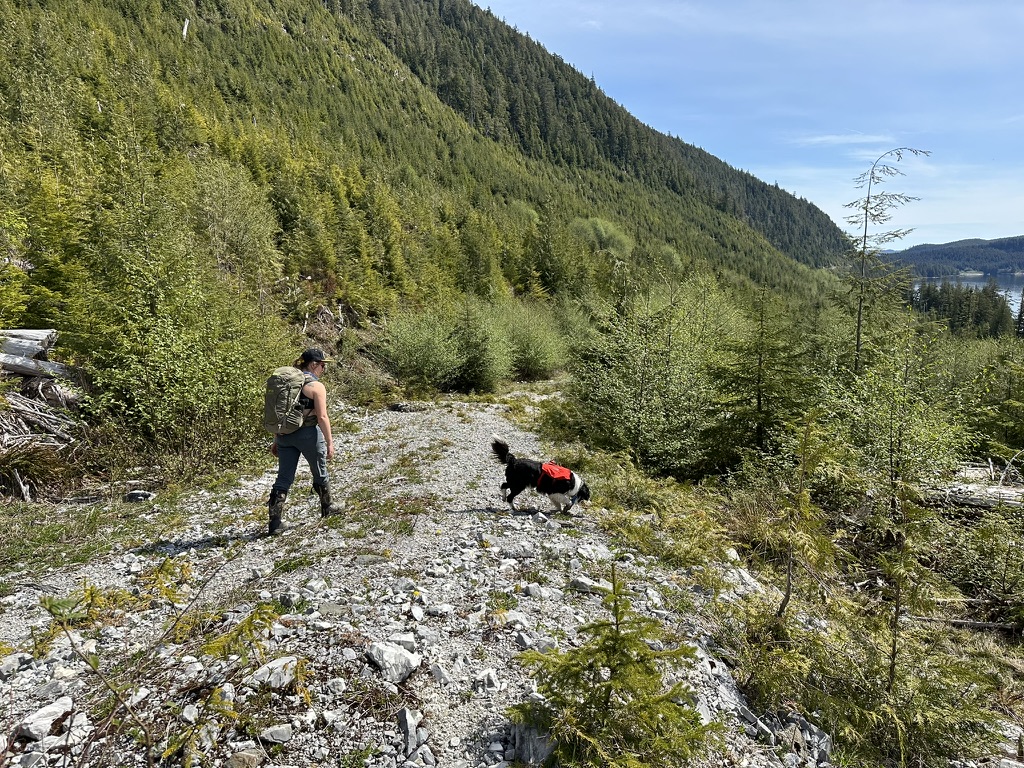
The breeze and evaporating rain play tricks on Barley’s nose all day, the scent climbing toward the sun rather than lingering in the moss or billowing in consistent plumes. Several times he sniffs up and down a cow parsnip or salmonberry, his nose almost prehensile as it hoovers up scent molecules. Eventually he blows out and folds into a down, nose pointed at the plant. Dutifully I kneel, combing through the gravel and leaves in search the a scat in front of his nose. It is not there; each time it lies less than a meter away. The odor swirled and collected in the leaves of the plant, creating a ghost scat he can see through scent. I reward him for these finds; detection dogs are trained to find the highest concentration of odor. Usually that is at the scat, but sometimes the scent wanders and pools in the lee of a cedar sapling.
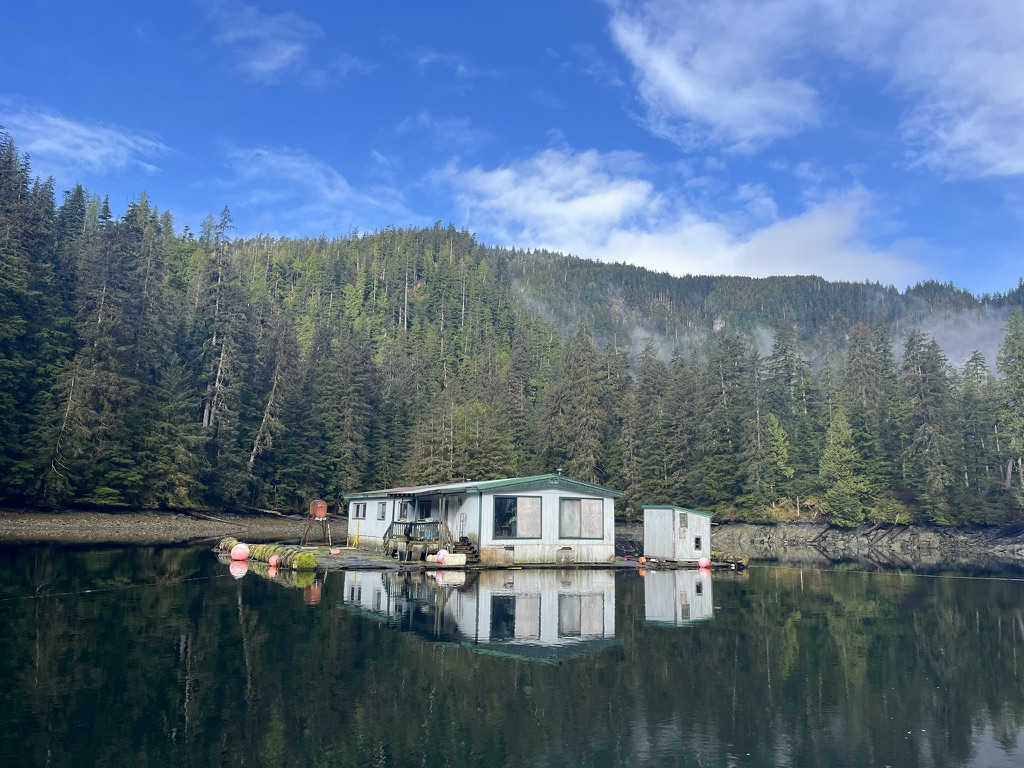
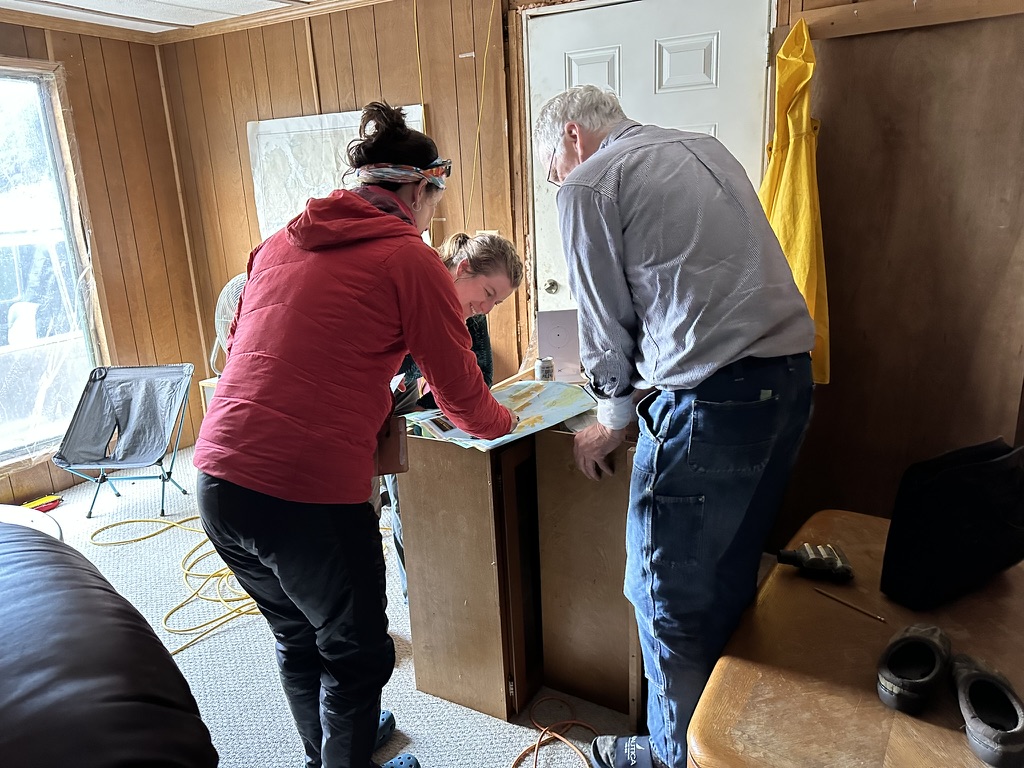
Ten scats later, we load up onto the boat, my face pink and warm from photosynthesizing. With Gretchen at the bow spotting shallow rocks, Michael navigates into a tiny polyp-shaped cove. At the far end floats an old logging bunkhouse, white and green with peeling paint and algae stains. The wraparound porch has holes through which you can see jellyfish puffing about like cottonwood seeds on the wind. It is musty and cluttered and warm and dry. We have been given leave to stay here, in this half-sunken float house. With a wood fire crackling in the stove and stagnant air escaping through open windows and a happy dog rolling on the carpet, it feels like home. I am half asleep as we pore over imagery and plans for the next day, fully asleep before the sun sets. Barley pours into the oxbow between my thighs and my stomach. I have a synesthesia-like dream of glimmering scent filtered through spruce needles, an aurora of odor that I can only see through Barley’s nose. His snuffling and paw twitches tell me that he has joined me on the dream hunt.
The next morning I wake dreading the reappearance of a sore, stiff, specter of an aging dog. Instead, Barley stretches and shakes and hops into bed with Toni, licking her awake before trotting purposely to the food bin. He plants himself in front of it and waits to be served. He is bright and vibrant and perfect. I exhale.
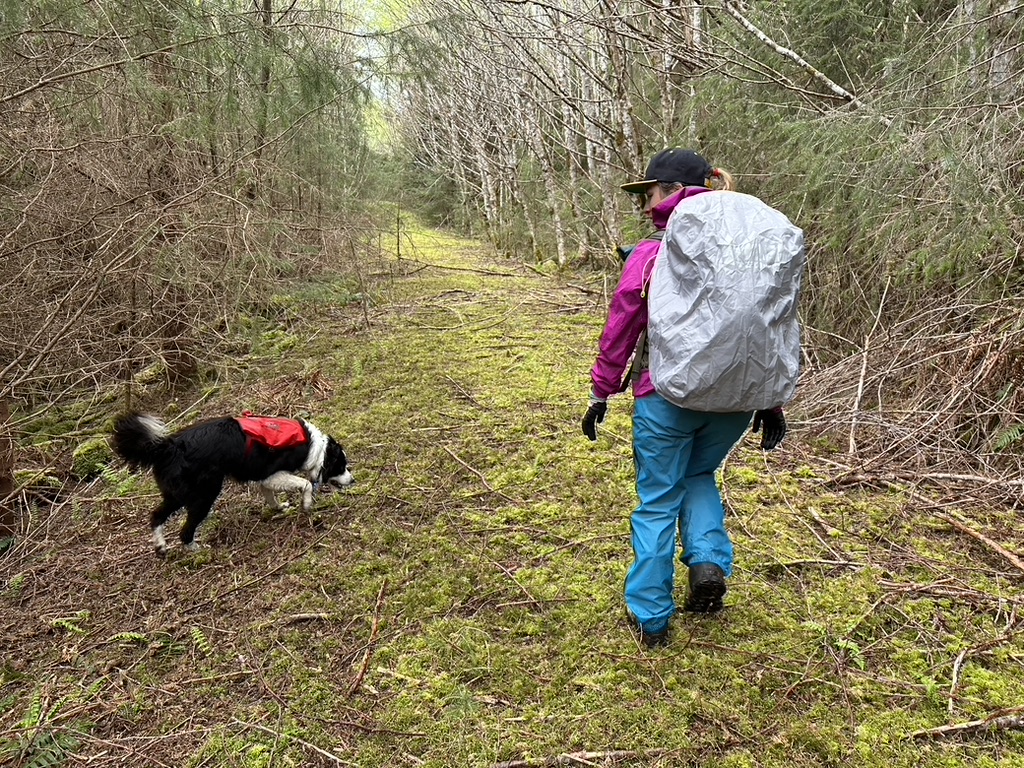
We drop Gretchen off on one side of Long Island and then head to the other. We will walk the logging roads that carve across the island and meet Michael near a logging camp. Our route is about six miles as the crow flies, the winding road much longer. The weather is back to cool drizzle and chinchilla-soft clouds as far as the eye can see. Things start slow; we travel for nearly a mile before our first scat. Barley diligently points out mustelid scats for a piece of kibble each; this compromise keeps him focused and happy as we search for the real prize. This also tells me how the odor is moving, how focused he is, and confirms that there is no wolf scat odor in the area. If there were, he would never choose a mustelid-kibble over a wolf-ball.

The first scat lies at a road junction, the second a 100 meters beyond. The third, fourth, and fifth follow close behind; a whole group of wolves with full bowels may have passed here. Or perhaps it is a favorite message-board of just a few. We will find traces of answers in the genetics months from now. As we follow the road through muskeg, Barley points out scat after scat. At his thirteenth find of the day, I call him a rat bastard, my heart swelling with joy and love and pride. At the twenty-second, Toni begs him to take it easy on us, but we are beaming and I throw him his ball just the same. Our quads are sore from squatting to inspect scats, collect them, take notes, and stand again with heavy packs. We find twenty six scats.
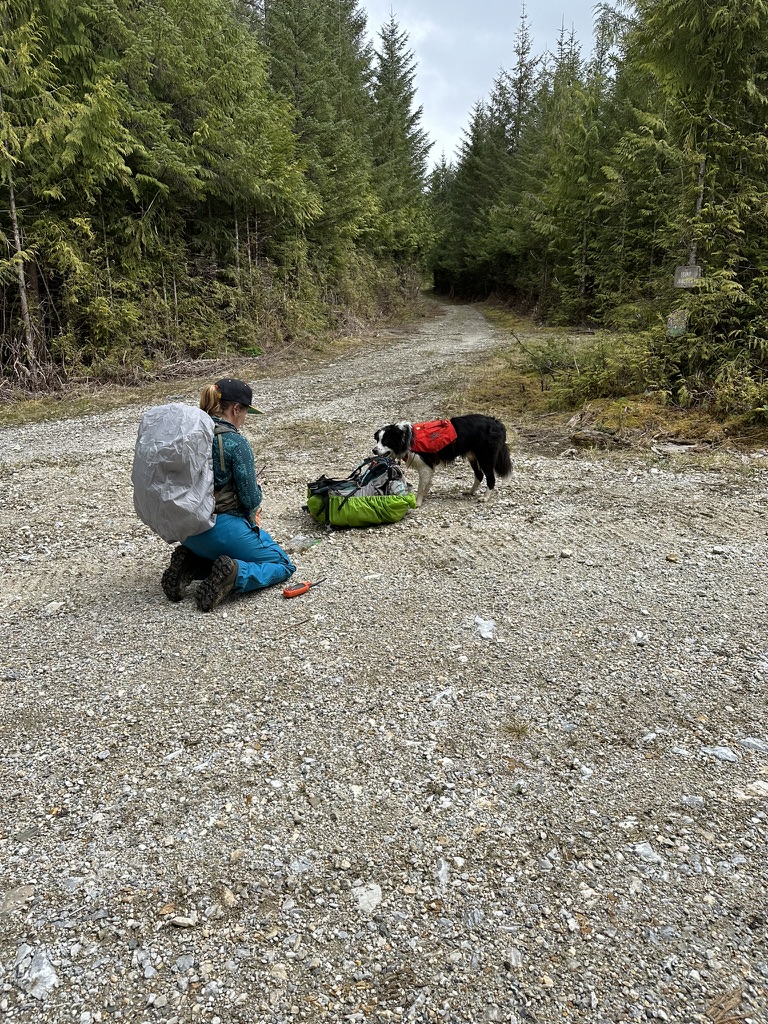
We catch Gretchen as we approach the logging camp; she has five scats in her pack. We meet Michael chatting with the loggers and he hands us one labeled plastic bag of scat. The logger tells us about sightings of twelve wolves, including pups, in the area. Just as we are ready to head home, he mentions he is Salvadoran. I turn towards him, brightening. “Vos sos de El Salvador?”
He laughs and demands why we made him speak English this whole time if I spoke Spanish. We exchange information about his canton, where I visited and stayed, how we are connected to the country, when we each will return and when we were last there. As we walk away, I yell a promise to bring masa to make pupusas with the crew next time we are on the island. I hope that our search schedule aligns with their logging again. That night Gretchen breaks out palomas in celebration of Cinco de Mayo and I highlight passages on camera trapping methodology in scientific papers.
The next day our goal is to check several small islands that may serve as ephemeral hunting grounds for wolves. Not large enough to support a constant population of wolves, these islands can be crawling with deer or serve as haul-outs for sea otters. Occasionally, the wolves may paddle over from a larger island for a meal. We do not know how often they come or how long they stay. That is part of why we are here.
It is rainy again. We climb out of the boat onto barnacle-encrusted rocks, sharp under Barley’s paws. The island has a narrow waist, a pinch point across a grassy zone with kelp strewn like streamers after a surprise party. A perfect spot for a camera trap; but first we will see if Barley can sniff out any scat.
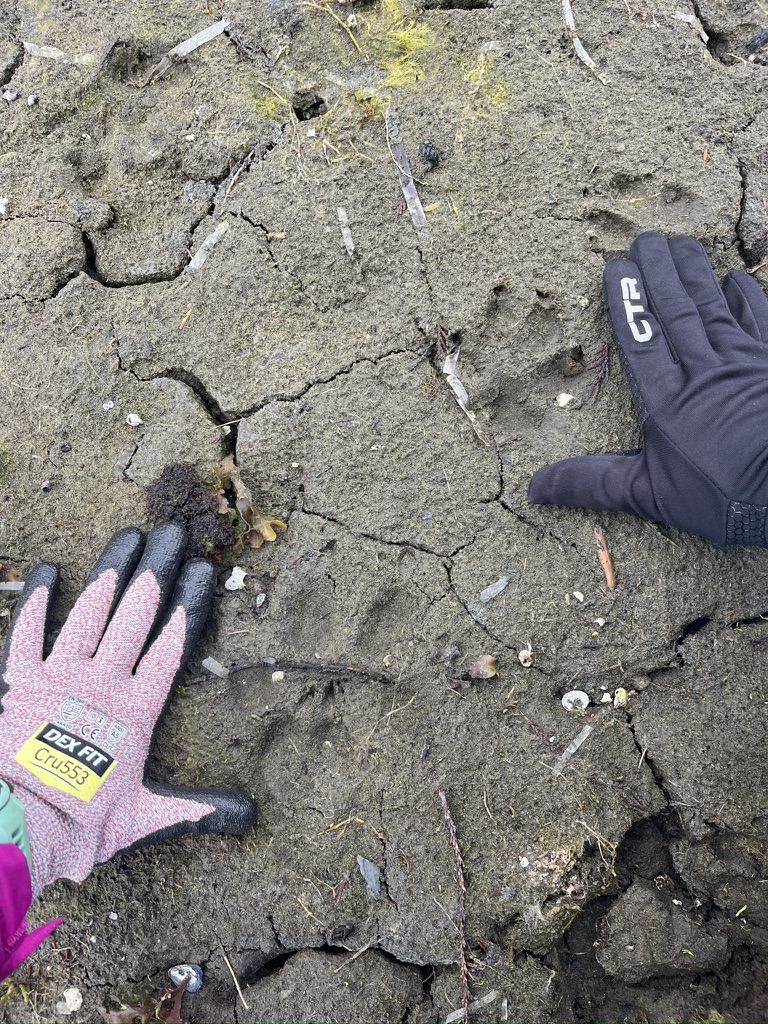
While Barley circles out to check along the treeline, I angle towards a mudflat to check for tracks. I see one, huge and clawed. It is clearly a wolf, but it is so large that for a half second I think bear. I squat down to look at it, and feel my period start. It is barely 9am and I left my Diva cup back at camp. Toni does not have anything with her either. I make a quiet excuse and pick my way into the woods, search out a fluffy but dry-ish chunk of moss, and stuff it in my underwear. I spend the rest of the day changing out the moss every few hours. It works pretty well, as far as moss goes.
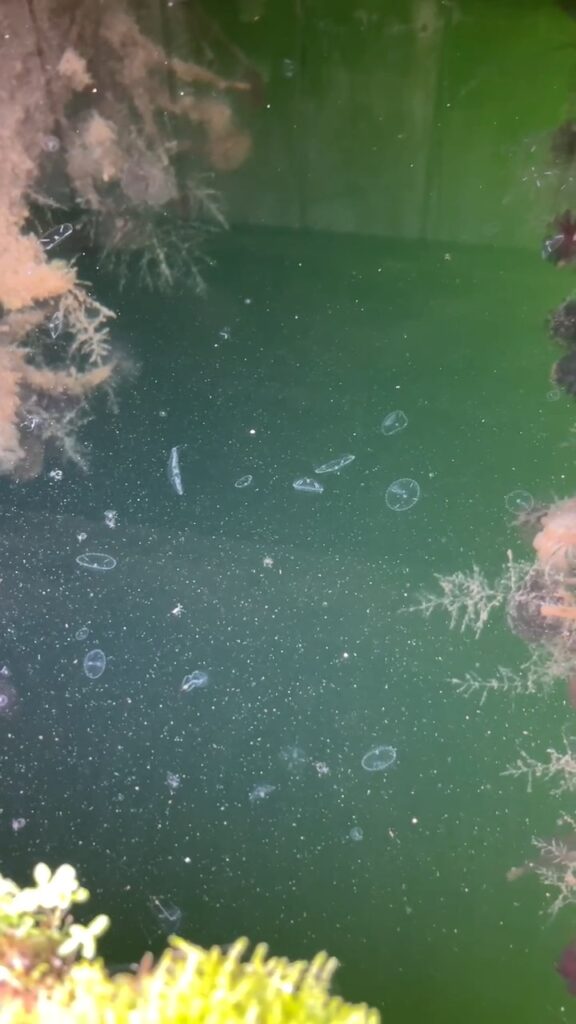
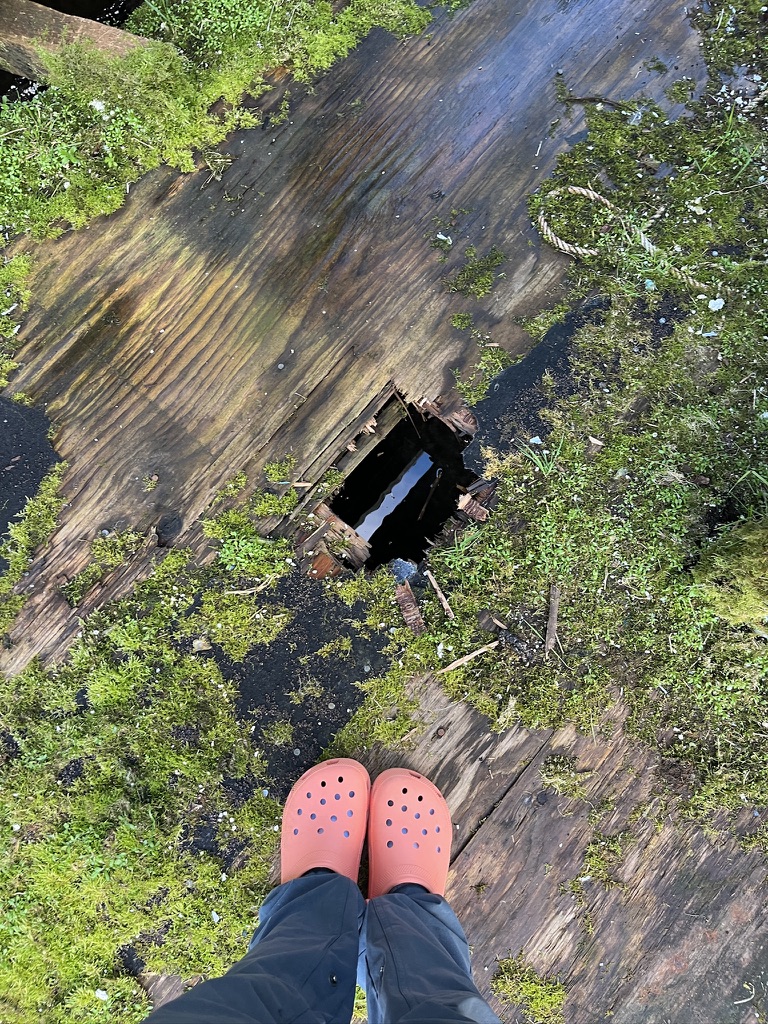
Barley does not find any scat despite the ultra-fresh track. We set the camera trap and head to the next island, where we find a single scat and another natural funnel to place a camera trap. At the third small island, we all find a half dozen gleaming abalone shells. The abalones are harder to find since the sea otters returned, but this beach is a hotspot. I am grateful to clean up back at the float house and we all crumple into the sofas, our field clothes steaming above the stove. When I step outside to turn on the propane tank, my foot punches through the porch and stops just short of the jellyfish-laden water below. A reminder that the float house is not quite paradise, though it feels like it.
The next morning Barley wakes spry and hungry, his eyes sparkling cavernous saucers as he awaits breakfast. I prepare soupy kibble and protein powder and joint supplements before serving my own sludge of oatmeal and peanut butter and chia seeds and dried fruit. We load the boat with all of our gear and motor away, back towards Craig.
Barley gets an extra rest day today while we check a potential den site. It is a nasty but short bushwhack to a beaver pond with a raised peninsula ringed with old cedars; perfect for the wolves to burrow under the roots without piercing the water table. We heft our boots over slick logs and duck under pendulous drips of moss. The closer we get to the den, the quieter we get. I am painfully aware of how clumsy my boots are; it feels impossible to quietly navigate the sucking mud and snapping sticks. How do twigs so tiny and wet make such a sharp, loud crack?
We spot tufts of white deer hair. I am hopeful and excited and nervous, my eyes scouring the earth ahead of me for signs that the wolves are here this year. Toni and I exchange a few secretive grins behind the backs of the Alaskans as we get closer to what may be our first active den. It feels like, as a child, being invited to wrap Christmas presents from Santa for your younger sister, like being let in on a secret.
But as we get even closer, I notice how dense the deer tracks are. How there are no wolf prints. My hope deflates, but I do not say anything. 300 meters before we reach the den site, Michael says he does not think they are here. We poke around anyway, kicking at the bones strewn from meals past and peering into the cavernous den where roots reach downward like stalactites.
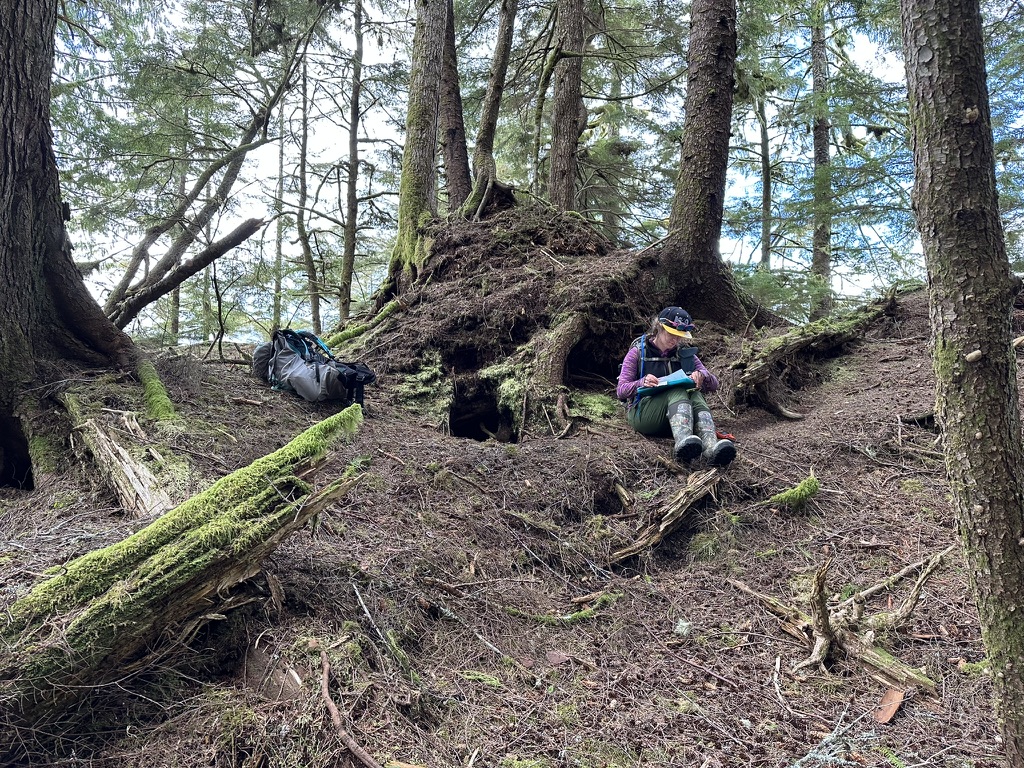
The ocean is rolling on our way home, boiling and bubbling and whitecapped. Barley presses his forehead into my armpit and holds my quads tight, his claws digging into my field pants. For once, he lets me contain him; even holding me back. He is not trembling, just holding on. I wrap my arms around him and watch the rain stream across the windows, feeling like a child in the backseat of a car on a long road trip. The boat is squirrely, shearing strongly when broadsided. Every so often, she dips so far to one side that I catch a glimpse of inky spruce or gunmetal water.
That night, Toni and I are exhausted but I am determined to check out a line dancing group at the bar. When we open the doors, we see a small group of septuagenarians, grapevining to the right with their backs to us. When they clap and pivot, I see their faces. They are almost scowling, twirling and clapping and stomping without an ounce of joy. We turn and flee; perhaps we can bring the energy and smiles next time, but this time we are too tired.
I collapse onto the cot in the canvas tent and Barley pools against my spine, his chin filling the soft space between my hips and ribs. I feel him scenting in his dreams but cannot join him on this otherworldly hunt yet. He is spilling through me, over me, around me. I cannot quite capture his brilliance even as I hold him. Canyons only contain rivers on two sides. When Barley flows away, courses through and into and beyond me, he will leave a chasm impossibly deep. The Columbia seems a trickle when viewed from the lip of the gorge and my next dog will never fill Barley’s canyon either. Niffler is already pouring into the gash, spilling and filling and carving his own path into my heart. He, too, will leave side canyons and oxbows and an even deeper channel. I can hardly imagine my beloved trickle of a puppy as a creek, let alone a mighty river that forms canyons of his own, but he will. Then the next dog, and the next, and the next. The dogs to come are tributaries like the Flathead and Bitterroot and Pend Orielle. But it will always be Barley’s canyon first, just like the Columbia River Gorge belongs to its namesake more than to the Clark Fork. This week, I cry not because Barley is in pain but because I am terrified of the pain I will feel when all I have is the gulf he carved into me and no black-and-whitewater to fill it in.
We love to hear from you. Please share this post and ask us questions in the comments if you enjoyed this piece. It helps us know you’re there and feel inspired to continue sharing stories.

